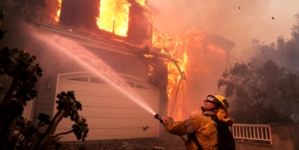-
US Citizen Detained After Visiting Canada: ‘Treated Like a Criminal’ - 14 mins ago
-
Orioles vs. Guardians Highlights | MLB on FOX - 30 mins ago
-
‘Seinfeld’ star says ‘very religious’ parents ‘hated’ his work - 36 mins ago
-
Kidnapped U.S. pastor rescued in South Africa after ‘high-intensity shootout’ - 39 mins ago
-
US Toughens Stance on Iran, Raising Risk of War - 53 mins ago
-
Legendary entertainer Pat Boone fears ‘terrible time of strife’ in America - about 1 hour ago
-
Mets vs. Twins Highlights | MLB on FOX - about 1 hour ago
-
2025 NFL Mock Draft: Giants Make Up For Letting Saquon Barkley Leave - 2 hours ago
-
Hungary’s parliament adopts 15th amendment of Fundamental Law - 2 hours ago
-
2025 NBA Play-In Tournament highlights: Warriors, Magic clinch playoff berths - 2 hours ago
Pelicans fall victim to toxic algae bloom across Southern California
Brown Pelicans across Southern California are filling up wildlife rehabilitation centers, either sick or starving — a dual crisis that wildlife experts believe could be linked to a massive toxic algae bloom.
For the last month, hundreds of seabirds have been poisoned by domoic acid, a neurotoxin produced in harmful algal blooms that are consumed by filter-feeding fish, such as anchovies and sardines. The small fish aren’t affected by the toxins, but many seabirds and marine mammals that feed on these fish are, and the sickness can be deadly. More than 100 area seas lions have been sickened and killed by the toxins over the last few months, along with several dozen dolphins that have died.
Over the last month, hundreds of seabirds have been poisoned by domoic acid, a neurotoxin produced by harmful algal blooms. The disease is highly deadly.
(Newt Likier/Wetlands and Wildlife Care Center)
But more recently, officials have also been responding to an influx of baby pelicans that aren’t sick from the toxins — but are struggling to survive because they’re extremely malnourished.
Officials think the two phenomena are related: as more adult pelicans become sick, disoriented or die, that has left more and more baby pelicans to fend for themselves, leaving their nests prematurely when they don’t yet know how to fish.
It’s just a theory right now, but experts say it would help explain the unprecedented number of starving baby pelicans turning up at wildlife rescue centers.
“It is unusual for us to receive such a high volume of chicks that are this young,” the International Bird Rescue, a global conservation organization that has one of its largest wildlife rescue centers in San Pedro, wrote on its website. “Many are very young birds, not fully grown, and do not seem to understand how to feed themselves.”
“They are just starving and cold and sad,” said Rebecca Duerr, the center’s director of research and veterinary science. At its San Pedro location, specialists were caring for 60 pelican babies as of Tuesday, with more arriving every day, Duerr said. That’s in addition to about 50 other birds, many adult pelicans, that have come into the center over the last month because of the domoic acid poisoning. More than half of the birds have since died.
“We keep thinking it’s over and then we get more birds,” Duerr said of the influx.
There have been other times in recent years when the California brown pelican, a federally protected species, has been found dead or emaciated in high numbers, and other years when large numbers of animals have become sick from domoic acid as the algae bloom is naturally occurring. But the concurrent events this year are especially concerning to officials.
Debbie McGuire, the executive director of the Wetlands and Wildlife Care Center in Huntington Beach, said she believes runoff from the Los Angeles firestorm likely elevated this year’s bloom, as changes to nutrient levels in the ocean can increase the strength and length of the bloom. Officials don’t yet know how long this bloom will last. Scientists have also found that human-caused climate change and warming ocean waters can also increase the growth of harmful algae blooms.
McGuire said she can’t remember a time in the last 20 years when her organization has treated this many birds with domoic acid at one time, noting that it is testing the center’s workforce and capacity.

The Wetlands and Wildlife Care Center in Huntington Beach is struggling to keep up with the number of brown pelicans at its rehabilitation center. Scores of the seabirds have been found sick and starving.
(Newt Likier/Wetlands and Wildlife Care Center)
“My staff is burning the midnight oil for a month now,” McGuire said. “It’s hard on them — a lot of compassion and love goes into our work.”
As of Tuesday, she said her team is caring for almost 60 brown pelicans, up seven from the day before — and most require intensive care, often including anti-seizure medication, IVs or lessons on how to feed themselves. Still, more than 50% of the pelicans they’ve taken in over the last month have died, as many birds sickened by domoic acid cannot be saved if the illness has progressed too far.
“If we get them quick enough we can save them, but time is of the essence,” McGuire said.
The two centers said people have found the disoriented birds in unexpected and often hazardous locations over the last month, including on the 405 Freeway, on a terminal at LAX and near Amazon warehouses.
The birds “don’t know where they are, they get confused, they fly inland,” McGuire said.
Both rescue centers are also treating other seabirds ill from domoic acid, including the western grebes, brandt’s cormorants and red-throated loons, but brown pelicans have most frequently been sick. Neither location has reached capacity yet, but McGuire said it’s a concern if the situation continues at current rates.

Brown pelicans across Southern California are filling up wildlife rehabilitation centers as scores of the seabirds have been found sick and starving.
(Newt Likier/Wetlands and Wildlife Care Center)
In a recent post on social media, the Wetlands and Wildlife Care Center asked for monetary donations or items on their wishlist to help ensure they can keep providing the care the animals need. The International Bird Rescue also has asked for donations to help it respond to what its called a seabird crisis.
“Stress is high as we care for over 52 pelicans, many of whom are not yet eating on their own, with no clear sign of slowing down soon,” the Wetlands and Wildlife Care Center said in its post.
Officials warned beachgoers to use extreme caution when approaching any sick or dead animal, including seabirds. If you encounter one, the International Bird Rescue urged people to call the organization’s bird helpline at (866) 767-2473. The Wetlands & Wildlife Care Center recommended people to call their local animal control office or find more information online.
Times staff writer Summer Lin contributed to this report.
Source link































